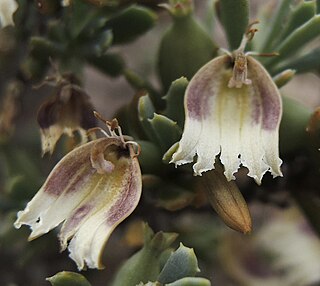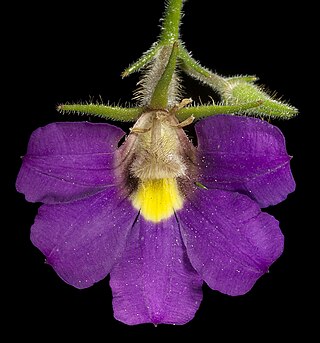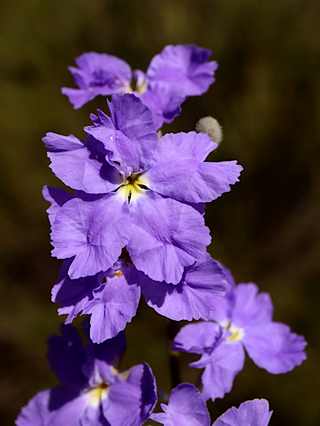
Eremophila gibsonii is a flowering plant in the figwort family, Scrophulariaceae and is endemic to Australia. It is a sticky, glabrous, rounded shrub with narrow leaves and white to lilac-coloured flowers and which occurs in Western Australia, South Australia and the Northern Territory.

Dampiera altissima, commonly known as tall dampiera, is an erect perennial herb of the family Goodeniaceae and is native to Western Australia. It is a perennial herb that generally grows to a height of up to 0.5 m and has flat, green-grey leaves. The leaves are mostly round and are between 8–60 mm long. Dampiera altissima flowers during the winter and spring, unveiling small blue-purple flowers. The herb is a ground cover plant found growing on the sandplains, laterite and sandstone of the southwestern region of Western Australia, most common in the Geraldton area north of Perth. The species is sometimes grown as an ornamental plant and is listed as “not threatened”.

Dampiera wellsiana is a herb in the family of Goodeniaceae and is one of approximately 70 species of Dampiera. Dampiera wellsiana is native to Western Australia. It is a non-threatened, stoloniferous plant and is often defined by its small blue petals and the arid climate it grows in. Botanist Ferdinand von Mueller first described the plant in 1876.

Pityrodia hemigenioides is a flowering plant in the mint family Lamiaceae and is endemic to the south-west of Western Australia. It is a spreading shrub with densely hairy branches and leaves, and pale white flowers near the ends of the branches.

Scaevola amblyanthera is a small shrub in the family Goodeniaceae which is found in tropical and central Australia.

Bertya opponens is a shrub/tree in the family Euphorbiaceae, native to Australia and found in New South Wales and Queensland. It is found on ridges amongst mallee in shallow soils. It flowers in July and August.

Scaevola collaris is a shrub in the family Goodeniaceae and its native range is five mainland states/territories of Australia: the Northern Territory, New South Wales, South Australia, Queensland and Western Australia.

Scaevola humifusa is a prostrate shrub in the family Goodeniaceae, native to Western Australia. It grows to a height of 0.01 to 0.5 m, and its white-cream/white-blue flowers may be seen from August to November or January.

Scaevola parvifolia is an erect, many stemmed perennial in the family Goodeniaceae, which is native to Western Australia, the Northern Territory, Queensland and South Australia. It grows to a height of 0.6 m, and its blue-purple flowers may be seen from March to October.

Scaevola phlebopetala, commonly known as velvet fanflower, is a herb in the family Goodeniaceae and is endemic to Western Australia.

Dampiera dentata is a plant in the family Goodeniaceae, native to Western Australia and the Northern Territory.

Dampiera alata is a plant in the family Goodeniaceae, native to Western Australia.

Goodenia armitiana, commonly known as narrow-leaved goodenia or fine goodenia, is a species of flowering plant in the family Goodeniaceae and is endemic to northern Australia. It is an erect herb with sticky or vanished cylindrical leaves, racemes of yellow flowers with leaf-like bracts at the base, and more or less spherical fruit.

Goodenia azurea, commonly known as blue goodenia, is a species of flowering plant in the family Goodeniaceae and is endemic to northern Australia. It is an erect, dense, spreading or sprawling, glaucous, perennial herb with egg-shaped leaves with the narrower end towards the base, racemes or thyrses of bluish-purple flowers with leaf-like bracts, and oval to cylindrical fruit.

Goodenia sepalosa is a species of flowering plant in the family Goodeniaceae and is endemic to northern Australia. It is a prostrate to ascending herb with narrow oblong to lance-shaped leaves, the narrower end towards the base, and racemes of yellow flowers.

Dampiera rosmarinifolia, commonly known as rosemary dampiera, is a flowering plant in the family Goodeniaceae.It is a perennial subshrub with linear leaves, mauve or purple flowers borne in leaf axils.

Dampiera incana, commonly known as the hoary dampiera, is a flowering plant in the family Goodeniaceae and is endemic to Western Australia. It is a perennial herb with grey foliage and blue-purple flowers.

Dampiera lavandulacea is a flowering plant in the family Goodeniaceae and is endemic to Western Australia. It is a small, upright shrub with blue flowers.

Dampiera ferruginea commonly known as velvet beauty-bush, is a flowering plant in the family Goodeniaceae and is endemic to Queensland. It is a small, upright shrub with blue flowers.

Dampiera juncea commonly known as rush-like dampiera, is a flowering plant in the family Goodeniaceae and is endemic to Western Australia. It is a small, upright perennial with blue-purple flowers.




















